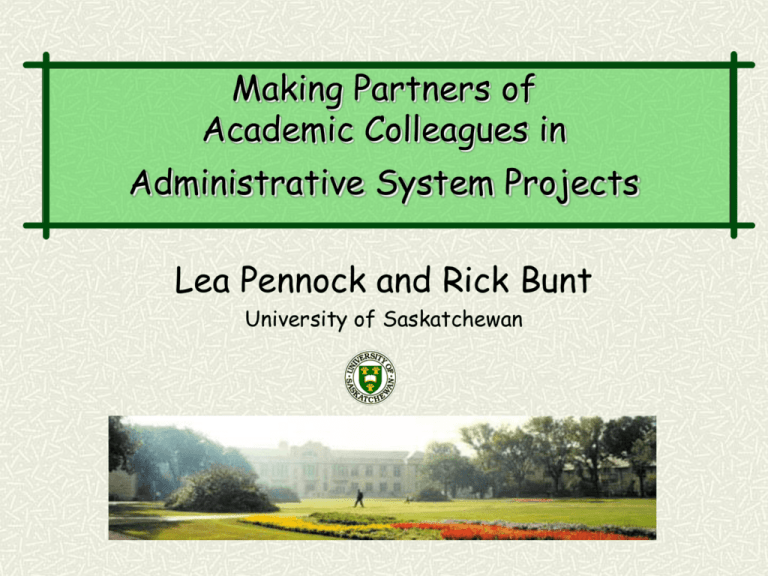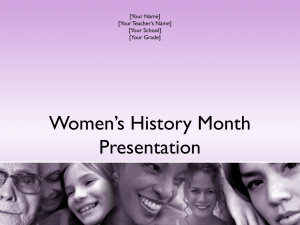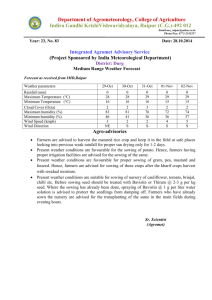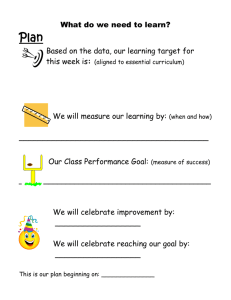Portal Project Overview
advertisement

Making Partners of Academic Colleagues in Administrative System Projects Lea Pennock and Rick Bunt University of Saskatchewan Who We Are Dr. Lea Pennock •Director, Student Information Systems • 15 years in the Office of the Registrar (experience at three universities) •sometime lecturer in English Dr. Rick Bunt •Associate VP, Info & Comm Technology •30 years as a Professor of Comp Science •sometime Dept Head, Associate Dean, ... slide 2 What We’re Doing Like everybody, we’re renewing our administrative support systems. Articulated as a strategic priority in the U of Saskatchewan Institutional Plan. “We are also committed to the renewal of our core administrative support systems ... and to the delivery of integrated, role-based, on-line services to our customers, both within and outside the University. These new systems will provide exciting new functions and services, and the powerful workflow and integration tools that come with these products will enable the interoperability we require and help us achieve the cross-functional services that our users demand.” slide 3 Where We Are PeopleSoft HR System implemented 5 years ago Banner Student implementation underway Luminis Portal released 2003/04 Banner Finance implementation underway Coming attractions: Library system upgrade, Donor management system, ... slide 4 What This Talk is About We’re not going to talk about implementation of ERP systems, from either the technical side or the project management side Our focus might be called the cultural dimensions of administrative system implementation How the university community is predisposed to view such projects How to cultivate the community readiness and buy-in we need to be successful slide 5 Our Thesis Universities are unique places of business The collegial system The “faculty factor” A university environment defies some of the expectations and assumptions upon which classical project management is founded A university project requires some different approaches slide 6 How many academics does it take to change a light bulb? CHANGE???? slide 7 An Agricultural Metaphor ... This is Saskatchewan, after all ... slide 8 Outline Climate and soil conditions Preparing the ground Sowing the seeds Tending the crop Weeds and other pests Harvest Thanksgiving slide 9 Climate and Soil Conditions The climate and soil conditions at a university are far from ideal for the implementation of a large administrative system Universities are not particularly supportive of new and innovative IT initiatives [ECAR, “IT Leadership in Higher Education: The Condition of the Community”, January 2004] Faculty resist such expenditures slide 10 Climate and Soil Conditions The climate can be especially cool for initiatives seen to come from “the administration” slide 11 Preparing the Ground Year-long Needs and Options phase Enormously worthwhile investment of time and money helped us to identify the various stakeholders of the system got us campus buy-in, but also buy-in from the Senior Administration and the Board of Governors (2 presentations) gave us a chance to sell the idea that this was a university-wide project, and Gave our fledgling project team a chance to establish credibility and confidence slide 12 Preparing the Ground Site visits are very helpful during this phase To learn about both products and projects To make contacts Consultants and vendors can also help, but use them wisely They know about implementing software but we know about what’s important to our community, and especially the importance of consultation and process in a university setting slide 13 Preparing the Ground: Project Governance Create a governance structure that reflects your institutional values collegiality, representation, accountability, ... ensure you have academic representation (faculty, students, deans) Provost/VP Academic chaired our Steering Committee don’t duplicate decision-making structures and bodies that already exist co-opt them slide 14 Preparing the Ground: It’s Not Just About Software A project like this presents opportunities for re-thinking the way you do things for re-evaluating your institutional decision-making processes for re-configuring your governance structures for identifying (and sometimes altering) the formal and the “real” authority for your policies and processes for discovering things about your institution that nobody remembers the history of, or the reasons for slide 15 Sowing the Seeds Product Selection phase Continued focus on project as much as on product Developing an RFP is an exercise in refining and thinking through the institution’s needs Site visits were (again) extremely valuable Invited broad campus participation and comment on vendor visits/demos slide 16 Sowing the Seeds: Some Early Lessons The importance of faculty and student support The importance of external advice The importance of being up-front about what the project will cost and what the returns will be on that investment slide 17 Sowing the Seeds: Communication Strategy Many messages need to be communicated to get community acceptance of the project Develop a communication strategy: Vision and goal for the project System will support the academic mission of the university —teaching, learning and research. Can’t assume that the “goals of the institution” are monolithic Different audiences have different goals and priorities. slide 18 Sowing the Seeds: Communication Strategy More elements: Need to build community trust in both the project leaders and the project team. Get the faces of project people “out there”. Build positive image of team in the community: capable, enthusiastic, positive, committed to institutional goals and attuned to institutional values. Put the project on the big stage — a university project. slide 19 Sowing the Seeds: Communication Strategy Different audiences need/want different things: Students: Comfortable with technology: want anytime, anywhere access to services, and want it now Don’t want (or need) to know which office has responsibility for what Faculty: Comfort with technology varies substantially Like to do things for themselves but resist being trained Don’t want to be taken by surprise slide 20 Sowing the Seeds: Communication Strategy Deans, Dept Heads, Committees of Council/Senate: Concerned about who has authority for what Concerned about “downloading” work, but sensitive to institutional efficiencies Administrative Staff: High level of technical sophistication Need to know which office/person has responsibility for what Things like system speed and number of keystrokes are very important slide 21 Tending the Crop Implementation and Change Management Avoid temptation to “hole up” during implementation Continue to grow, nurture, and coax your community of support not a task for the Project Manager, who is fully consumed with in-project responsibilities Need an effective Project Ambassador/Evangelist who continues to communicate Look for “quick wins” slide 22 Weeds and Other Pests: Myths, Misconceptions, Rumours The system as tyrant: “the system is going to drive our academic policies” Replace this perception with the proposition that we should make best use of the tool that we’ve invested in Emphasize project over product: project is providing an opportunity for change slide 23 Weeds and Other Pests The system as agent of corporate control: “your system is turning our university into a corporation…we’re turning our control over to central administration” Quite the opposite: distributed web-based systems empower users by giving them more control of their own data and processes Distributing control can re-vitalize the collegium slide 24 Weeds and Other Pests The system as black hole: “These funds could be much better spent on other things (hiring faculty, journal subscriptions for the library, lab or classroom renovations, …)” Let faculty know that you understand and share their anxieties, that you are not uncritical. Be sensitive. Talk about jointly-held goals/values rather than cost Find better analogies for costs new buildings, utilities, … Inspire confidence, demonstrate the value of this investment through the deliverables. Convince them it’s good for them! slide 25 Harvest Harvest incrementally Deliver in “tiny bubbles” rather than “big bang” Look for quick wins Under-promise, over-deliver soft roll-outs slide 26 Thanksgiving Celebrate, and think big when you celebrate! Invite the President, the Provost, your vendor’s CEO, everybody involved in the project, ... An opportunity not only to thank the team and celebrate their success but also to let the university know that something significant has happened. Sometimes the best way to tell the Provost or President that your team has done a good job is to get them to say so in a speech to the team! Don’t wait until the very end to celebrate. slide 27 Celebrate Creatively You worked long days and nights without solace On a product by no account flawless. Such a fabulous team You’re the cream-de-la-cream! Without you, U of S would be PAW-less. slide 28 Revisiting Dictates of Classic Project Management: Adjustments for the Academy Dictate: Get buy-in from the top. Be aware of the non-hierarchical structure of university decision-making. Every bit as important to get buy-in from the bottom. Dictate: Scope creep is bad. Don’t sacrifice opportunity in the name of scope. The academic community is accustomed to seizing opportunities and needs to be assured that you will be equally flexible should circumstances arise. slide 29 Revisiting Dictates of Classic Project Management: Adjustments for the Academy Dictate: Customization is bad. Yes, customizing a vendor system is expensive, but not customizing can be costly too. If the system is perceived as an impediment, what you gain in going vanilla will quickly be lost in support and buyin of users. slide 30 Revisiting Dictates of Classic Project Management: Adjustments for the Academy Dictate: Project charters contain fixed truths and can be returned to as an enduring reference. At a University the process of arriving at a document often has more weight/value than the document itself. An academic’s business is continually to examine, re-think the canon, and treat all texts as works in progress. slide 31 Lessons We Have Learned Cultivation is time and money well spent. Representativeness has its place. You know you’ve made a convert when you hear your words coming out of someone else’s mouth. Be conscious of the academic rhythms of your institution. Use existing structures and decision-making bodies wherever possible. Learn from others — other projects, other universities, user communities, ... Look for quick wins. slide 32 Lessons We Have Learned Not all institutions are the same; be sensitive to the formal and informal decision-making processes of your own institution, its tolerance for centralized coordination, standardization, consistency, and its mood. Can be a challenge for a vendor, consultant or implementation partner Not all projects are the same either; you need to be flexible about tailoring your approach to the project. And not all phases of a project are the same; different approaches serve different phases. slide 33 Caveats We’re not finished we don’t know the ending yet. But we are getting positive responses: from our Board of Governors from Senior Administration (President, Provost, …) from our students and faculty We have passed through “cost justification” with very little pushback on cost Our challenge now is to meet expectations, and we’re confident we will! slide 34 Questions? lea.pennock@usask.ca rick.bunt@usask.ca slide 35











